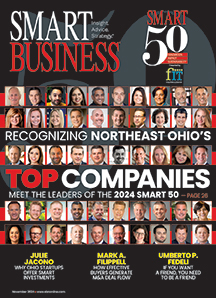When North American needed improved technology to remain competitive, Tim Wojciechowski and his marketing team turned to Japan.
North American, a ceramics manufacturer, supplied the steel industry and other capital-intensive industrial firms, so it was no surprise that customers were a little nervous.
“We were the first supplier to those industries to go outside the United States for technology from Japan,” recalls Wojciechowski.
But the process improvements that came from the initiative helped North American become more competitive. And, he says, “That’s where I learned you have to keep your product technology fresh and go wherever that is.”
Throughout his 20-year career, Wojciechowski has been a risk-taker. Some risks led to success, others to failure. It was those triumphs and tragedies that prepared the native Clevelander for his biggest challenge — taking technology that had only been made in the lab and commercializing it. That same vision has earned him a 2001 Innovation in Business Rising Star award.
Ahead of his time
Through his years in lead roles at manufacturing and engineering firms, Wojciechowski saw one common theme — the need for consolidated electronics material suppliers.
While running a division of Oglebay Norton, he risked his career by formulating a plan to reduce his division’s dependence on the steel industry, which accounted for 80 percent of Oglebay’s revenue, and branch out into electronics material supply. He wanted to consolidate the fragmented industry and develop multimillion dollar suppliers to offer bundled packages.
The plan fizzled at the board level; the board not only rejected the idea, it sold Wojciechowski’s division.
“It was the right plan at the right time, only we were trying to execute it maybe at the wrong company,” he concedes.
So armed with the belief that the greatest worldwide market impact would come from electronics, he trudged forward. An introduction to Neil Lubart and a new liquid crystal display film cemented that idea, and he put his energy source into the creation of Trivium Technologies Inc.
The perfect match
While Wojciechowski was out mastering the corporate world of manufacturing in Ohio, Lubart was busy specializing in the human interface side of technology at IBM.
Lubart co-created the first notebook computer marketed by IBM and says today’s laptops have the same design flaw: an inability to use light from two different sources. That means the liquid crystal display screens can be seen only in the most optimum lighting conditions.
Driven to improve on his original creation, Lubart invented an LCD film that utilizes ambient light when it’s available and battery generated backlight when it’s not. The technology allows users to read a laptop computer screen in the sun and could extend battery life.
“The LCD industry is slow but it’s still expanding,” Wojciechowski says. “It’s a $70 billion business expected to grow to over $100 billion in the next few years.”
Recognizing the impact of Lubart’s technology — a decrease in power source dependency could impact everything from watches and road signs to avionics, cell phones and TVs — Wojciechowski realized he could take the technology to market.
“Neil is a gifted scientist and can communicate with the very sophisticated investor without talking down,” Wojciechowski says. “Neil’s able to bridge that gap from the technology side to the business side.”
Lubart says it is Wojciechowski’s passion and experience that has moved Trivium in the right direction.
“There are some business executives that don’t have the vision; he does,” Lubart says. “If you don’t have the vision, you miss the opportunity.”
How to reach: Trivium Technologies Inc., (216) 574-6225

